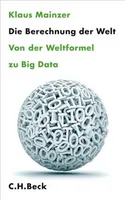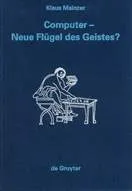Books

Quantencomputer – Von der Quantenwelt zur Künstlichen Intelligenz
Quantencomputer
Von der Quantenwelt zur Künstlichen Intelligenz
Springer: Berlin 2020
ISBN 978-3-662-61997-1
Die Quantenwelt ist längst im Alltag angekommen, ohne dass es vielen bewusst ist. Dazu gehören Transistoren, Dioden und Laser, die aus Alltagsgeräten nicht mehr fortzudenken sind. Nach dieser ersten Generation der Quantentechnologien leben wir derzeit in der zweiten Generation, in der Grundprinzipien der Quantenmechanik gezielt in quantenmechanischen Geräten umgesetzt werden. Dazu gehören erste Prototypen von Quantencomputern, klassische Supercomputer mit Quantensimulation, Quantenkryptographie und Quantenkommunikation, Quantensensorik und Quantenmesstechnik. Was Einstein 1935 als spukhafter Effekt vorkam, ist längst Grundlage umwälzender Quantenkommunikation in Glasfasernetzen und Satellitentechnik, die ein zukünftiges Quanteninternet ankündigt. Quantencomputer als Mehrzweckrechner sind nur die Spitze des Eisbergs mit einer Technologie, die sich schrittweise als Netzwerk unserer Zivilisation ausbreitet. Umso dringender ist es, die Grundlagen der Quantenwelt als Hintergrund dieser Technologie zu verstehen. Grundlagen und Zusammenhänge begreifen, von den mathematischen und physikalischen Grundlagen bis zu den technischen Anwendungen, ist ein zentrales Ziel des Buchs. Ein weiteres Anliegen dieses Buchs ist das Zusammenwachsen mit der Künstlichen Intelligenz. In meinem Buch „Künstliche Intelligenz. Wann übernehmen die Maschinen?“ (Springer 2. Aufl. 2019) wird Machine learning herausgestellt, das Automatisierung in Robotik, Industrie- und Arbeitswelt verwirklicht. Mit Quantentechnologie, Quantencomputer und künstlicher Intelligenz zeichnet sich aber nicht nur eine Potenzierung neuer Möglichkeiten ab, sondern auch von Gefährdungen. Daher erhebt sich die Forderung nach frühzeitiger Technikgestaltung, damit Quantentechnologie und Künstliche Intelligenz sich als Dienstleistung in der Gesellschaft bewähren.

Artificial intelligence – When do machines take over?
Artificial Intelligence
When do Machines take over?
Springer: Berlin
English translation of the 2nd German Edition 2019
ISBN 978-3-662-59716-3
Chinese translation; Tsinghua University Press: Beijing 2022
Everybody knows them. Smartphones that talk to us, wristwatches that record our health data, workflows that organize themselves automatically, cars, airplanes and drones that control themselves, traffic and energy systems with autonomous logistics or robots that explore distant planets are technical examples of a networked world of intelligent systems. Machine learning is dramatically changing our civilization. We rely more and more on efficient algorithms, because otherwise we will not be able to cope with the complexity of our civilizing infrastructure.
But how secure are AI algorithms? This challenge is taken up here: Complex neural networks are fed and trained with huge amounts of data (big data). The number of necessary parameters explodes exponentially. Nobody knows exactly what is going on in these "black boxes". In machine learning we need more explainability and accountability of causes and effects in order to be able to decide ethical and legal questions of responsibility (e.g. in autonomous driving or medicine). Besides causal learning, we also analyze procedures of tests and verification to get certified AI-programs.
Since its inception, AI research has been associated with great visions of the future of mankind. It is already a key technology that will decide the global competition of social systems. "Artificial Intelligence and Responsibility" is another central supplement to this book: How should we secure our individual liberty rights in the AI world? This book is a plea for technology design: AI must prove itself as a service in society.

Grenzen der KI – theoretisch, praktisch, ethisch
Grenzen der Künstlichen Intelligenz
theoretisch, praktisch, ethisch
Klaus Mainzer, Richard Kahle
Springer, Berlin 2022
ISBN 978-3-662-65010-3
Künstliche Intelligenz ist eine Schlüsseltechnologie, mit der sowohl in der Wissenschaft als auch in der Industrie große Erwartungen verbunden sind. In diesem Buch werden sowohl die Perspektiven als auch die Grenzen dieser Technologie diskutiert. Das betrifft die praktischen, theoretischen und konzeptionellen Herausforderungen, denen sich die KI stellen muss. In einer Frühphase standen in der KI Expertensysteme im Vordergrund, bei denen mit Hilfe symbolischer Datenverarbeitung regelbasiertes Wissen verarbeitet wurde. Heute wird die KI von statistik-basierten Methoden im Bereich des maschinellen Lernens beherrscht. Diese subsymbolische KI wird an den Lehren, die aus der Frühphase der KI gezogen werden können, gemessen. Als Ergebnis wird vor allem für eine hybride KI argumentiert, die die Potentiale beider Ansätze zur Entfaltung bringen kann.

Wie berechenbar ist unsere Welt
Wie berechenbar ist unsere Welt
Herausforderungen für Mathematik, Informatik und Philosophie im Zeitalter der Digitalisierung
Springer Verlag
Berlin 2018
ISBN 978-3-658-21298-8
Klaus Mainzer legt in diesem essential dar, dass die Zukunft von KI und Digitalisierung eine nüchterne Analyse erfordert, die Grundlagenforschung mit Anwendung verbindet. Berechenbarkeits- und Beweistheorie können dazu beitragen, Big Data und Machine Learning sicherer zu bewältigen. Dabei zeigt sich, dass die komplexen Herausforderungen der digitalen und analogen Welt in Grundlagenfragen der Mathematik, Informatik und Philosophie tief verwurzelt sind.

Information
Information
Algorithmus – Wahrscheinlichkeit – Komplexität – Quantenwelt – Leben – Gehirn – Gesellschaft
Berlin University Press
Berlin 2016
ISBN 978-3-7374-1322-0
Information ist einer der fundamentalsten Begriffe dieser Welt. Damit ist keineswegs nur gemeint, dass wir im Zeitalter digitaler Informationsverarbeitung durch Computer leben. Dieses Buch zeigt vielmehr, dass Informationsverarbeitung sowohl menschlicher Technik als auch der Welt insgesamt zugrunde liegt. Wir geben zunächst eine vorläufige Arbeitsdefinition des Informationsbegriffs, die in den folgenden Kapiteln schrittweise vertieft und ergänzt wird – unter den Gesichtspunkten von Algorithmus und Computer (Kapitel 2), Wahrscheinlichkeit (Kapitel 3), Komplexität (Kapitel 4), Quantenwelt (Kapitel 5), Leben (Kapitel 6), Gehirn (Kapitel 7) und Gesellschaft (Kapitel 8).
Aus dem Cover:
„Können Informationen in schwarzen Löchern verloren gehen? Welche Chancen und Risiken bieten Informationssysteme für unsere Wirtschaft und Privatsphäre? Lässt sich aus DNA ein Computer bauen? Information ist scheinbar alles und überall. Doch wie lässt sie sich berechnen? Welche Formen von Information können wir unterscheiden und welche Konsequenzen ergeben sich daraus für unsere Alltagswelt? Eine umfassende Einführung in ein zentrales Problem der modernen Wissenschaft von einem der führenden deutschen Komplexitätsforscher.“

Künstliche Intelligenz
Künstliche Intelligenz
Wann übernehmen die Maschinen?
Springer Verlag
Berlin 2016
ISBN 978-3-662-48452-4
Jeder kennt sie. Smartphones, die mit uns sprechen, Armbanduhren, die unsere Gesundheitsdaten aufzeichnen, Arbeitsabläufe, die sich automatisch organisieren, Autos, Flugzeuge und Drohnen, die sich selber steuern, Verkehrs- und Energiesysteme mit autonomer Logistik oder Roboter, die ferne Planeten erkunden, sind technische Beispiele einer vernetzten Welt intelligenter Systeme. Sie zeigen uns, dass unser Alltag bereits von KI-Funktionen bestimmt ist.
Auch biologische Organismen sind Beispiele von intelligenten Systemen, die in der Evolution entstanden und mehr oder weniger selbstständig Probleme effizient lösen können. Gelegentlich ist die Natur Vorbild für technische Entwicklungen. Häufig finden Informatik und Ingenieurwissenschaften jedoch Lösungen, die sogar besser und effizienter sind als in der Natur.
Seit ihrer Entstehung ist die KI-Forschung mit großen Visionen über die Zukunft der Menschheit verbunden. Löst die „künstliche Intelligenz“ also den Menschen ab? Dieses Buch ist ein Plädoyer für Technikgestaltung: KI muss sich als Dienstleistung in der Gesellschaft bewähren.

Die Berechnung der Welt
Die Berechnung der Welt
Von der Weltformel zu Big Data
C.H.BECK
München 2014
ISBN 978-3-406-66130-3
Big Data verändert alles. Spätestens seit den Enthüllungen Edward Snowdens ist klar: Eine unersättliche Überwachungsmaschinerie hat uns im Griff. Gewaltige unstrukturierte Datenmengen, die unser Leben abbilden, werden systematisch ausgewertet. Alles wird zu digitaler Information. Die Welt der Algorithmen beherrscht uns längst. Sie verändert unser Leben und unser Denken.
Klaus Mainzer zeigt in diesem Buch, wie es bei dem Vorhaben, die Welt zu berechnen, zu einer Revolution der Denkart kam. Während Generationen von Mathematikern, Physikern und Philosophen auf der Suche nach der Weltformel mit Gleichungen arbeiteten und in den Kategorien von Ursache und Wirkung dachten, ist die „new science“ dadurch charakterisiert, dass an die Stelle mathematischer Beweise und Theorien Computerexperimente und Algorithmen treten. „Korrelation“ statt „Begründung“, lautet die Devise des neuen Denkens. Die Korrelationen in Big Data sollen bislang verborgene Zusammenhänge aufdecken. Nach diesem Prinzip, schreibt das US-Magazin Time, will die 2013 von Google neu gegründete Medizinfirma „Calico“ an der Lebensverlängerung des Menschen arbeiten, indem nicht die Ursachen von Alter und Krankheit untersucht, sondern Unmengen medizinischer Daten mit Algorithmen ausgewertet werden.
Eine beispielslose Erfolgsgeschichte also? Mainzer stellt in diesem Buch die faszinierende neue Art der Wissensgewinnung vor, aber er macht auch die Gegenrechnung auf. Sein Buch ist ein Plädoyer für die Besinnung auf die Grundlagen, Theorien, Gesetze und die Geschichte, die zu der Welt führen, in der wir heute leben.

Local Activity Principle
Klaus Mainzer/Leon Chua
Local Activity Principle
The Cause of Complexity and Symmetry Breaking
Imperial College Press
London 2013
ISBN 978-1-908977-09-0
The principle of local activity explains the emergence of complex patterns in a homogeneous medium. At first defined in the theory of nonlinear electronic circuits in a mathematically rigorous way, it can be generalized and proven at least for the class of nonlinear reaction–diffusion systems in physics, chemistry, biology, and brain research. Recently, it was realized by memristors for nanoelectronic device applications. In general, the emergence of complex patterns and structures is explained by symmetry breaking in homogeneous media, which is caused by local activity. This book argues that the principle of local activity is really fundamental in science, and can even be identified in quantum cosmology as symmetry breaking of local gauge symmetries generating the complexity of matter and forces in our universe. Applications are considered in economic, financial, and social systems with the emergence of equilibrium states, symmetry breaking at critical points of phase transitions and risky acting at the edge of chaos.

The Universe as Automaton
Klaus Mainzer/Leon Chua
The Universe as Automaton
From Simplicity and Symmetry to Complexity
Springer Verlag
Berlin 2011
ISBN 978-3-642-23476-7
This booklet is an essay at the interface of philosophy and complexity research, trying to inspire the reader with new ideas and new conceptual developments of cellular automata. Going beyond the numerical experiments of Steven Wolfram, it is argued that cellular automata must be considered complex dynamical systems in their own right, requiring appropriate analytical models in order to find precise answers and predictions in the universe of cellular automata. Indeed, eventually we have to ask whether cellular automata can be considered models of the real world and, conversely, whether there are limits to our modern approach of attributing the world, and the universe for that matter, essentially a digital reality.

Leben als Maschine?
Leben als Maschine?
Von der Systembiologie zur Robotik und Künstlichen Intelligenz
Mentis Verlag
Paderborn 2010
ISBN 978-3-89785-714-8
Leben als Maschine ist spätestens seit der Renaissance eine wirkungsmächtige Metapher, die Menschen fasziniert und erschrocken hat. Die eigentliche Frage, die sich hinter der Maschinenmetapher verbirgt, zielt aber auf die Berechenbarkeit des Lebens ab. Gibt es Gesetze und Gleichungen wie in der Physik, mit denen Lebensvorgänge berechnet, erklärt und prognostiziert werden können? Mit den neuen Methoden der Biomathematik, Biophysik und Bioinformatik zeichnet sich diese Entwicklung in der Systembiologie ab. Synthetische Biologie baut Organismen nach den komplexen Schaltplänen der Systembiologie. Robotik orientiert sich zunehmend an kognitiven und intelligenten Organismen der Evolution. Auch Roboter haben dann komplexe Körper, mit denen sie ihre Erfahrungen und damit ihre Art von Intelligenz entwickeln.
Um die zunehmende Komplexität menschlicher Lebenswelt zu bewältigen, müssen technische Systeme adaptiver, autonomer und intelligenter werden. Wachsende Autonomie bedeutet aber nicht nur Probleme der Kontrolle und Berechenbarkeit, sondern auch von Ethik und Recht. Für Systembiologie, synthetische Biologie, Robotik und Künstliche Intelligenz (KI) heißt das, komplexe Systeme von neuen Mikroorganismen bis zu kognitiven Robotern als Dienstleister des Menschen zu entwickeln und ihn als Maßstab der Technik zu achten.
Besprechung in der FAZ 23.11.2010: online, Druckversion

Complexity
Komplexität
UTB Profile
W. Fink
Munich 2008
ISBN 978-3-8252-3012-8
The issues of "complexity" and "complex systems" are a dramnatic topic of world-wide research. The instability of politics, economies, finance markets and society is our daily experience. What can we learn from nonlinear dynamics of complex systems, from the emergence of order and self-organization in nature, in order to guide and govern our social systems? Which concequences can be concluded from the science of complexity? The booklet (120 pages) is a short and concise introduction to complexity research with a helpful glossary of essential concepts.


The Creative Chance. How Novelty comes into the World
Der kreative Zufall
Wie das Neue in die Welt kommt
C.H. Beck Verlag
Munich 2007
ISBN 978-3-406-55428-5
The world in which we live is not determined, but random. Randomness and risks, crises and new chances play a dominant role in nature and society. But how can order emerge from randomness and chaos? What are the degrees of randomness in complex patterns
of signals and information flow and how can we detect them? What do science and philosophy know? Klaus Mainzer brings together mathematics, physics, and computer science with evolutionary biology, brain research, economics, social sciences, and humanities. He shows how we can learn to live with randomness and to grasp creative chances in nature and society.

Thinking in Complexity
Thinking in Complexity.
The Complex Dynamics of Matter, Mind, and Mankind
Springer, Berlin/Heidelberg/New York/Tokyo 1994,
320 pages, 3rd enlarged edition 1997;
381 pages, 5th edition 2007
ISBN 3-540-72227-4
The theory of nonlinear, complex systems has become by now a proven problem-solving approach in the natural sciences. And it is now also recognized that many if not most of our social, ecological, economical and political problems are essentially of a global, complex and nonlinear nature. And it is now further accepted that any holistic perspective of the human mind and brain can hardly be achieved by any other approach. And in this wide-ranging, scholarly but very concise treatment, physicist, computer scientist and philosopher Klaus Mainzer discusses, in essentially nontechnical language, the common framework behind these ideas and challenges. Emphasis is given to the evolution of new structures in natural and cultural systems. And we are lead to see clearly how the new integrative approach can give insights not available from traditional reductionistic methods. The fifth edition enlarges and revises almost all sections and supplements an entirely new chapter on the complexity of economic systems.

The Complex Dynamics of Matter, Mind, and Mankind (Chinese)
The Complex Dynamics of Matter, Mind, and Mankind (Chinese)
2nd Chinese Translation of the 5th edition, 2011

Thinking in Complexity. The Complex Dynamics of Matter, Mind, and Mankind (Russian)
Thinking in Complexity.
The Complex Dynamics of Matter, Mind, and Mankind (Russian)
Russian Translation of the 5th edition
KomKniga Publishers: Moscow 2009
ISBN 978-5-397-00002-4

Thinking in Complexity. The Complex Dynamics of Matter, Mind, and Mankind (Polish)
Thinking in Complexity.
The Complex Dynamics of Matter, Mind, and Mankind (Polish)
Translated by Marek Hetmanski
Polish Translation of the German language edition
Wydawnictwo Uniwersytetu Marii Curie-Sklodowskiej: Lublin 2007
ISBN 978-83-227-2707-2

Thinking in Complexity The Complex Dynamics of Matter, Mind, and Mankind (Chinese)
Thinking in Complexity
The Complex Dynamics of Matter, Mind, and Mankind (Chinese)
Chinese Translation of the 2nd edition 1996
Central Compilation & Translation Press, Beijing (Peking) 1999,
440 pages, 2nd edition 2000
ISBN 7-80109-329-1/B

Thinking in Complexity The Complex Dynamics of Matter, Mind, and Mankind (Japanese)
Thinking in Complexity
The Complex Dynamics of Matter, Mind, and Mankind (Japanese)
Japanese Translation of the 2nd edition 1996
Springer: Tokyo 1997, 445 pages
ISBN 4-431-70734-4

Symmetry and Complexity The Spirit and Beauty of Nonlinear Science (English)
Symmetry and Complexity
The Spirit and Beauty of Nonlinear Science (English)
World Scientific Publishing Co. Pte. Ltd., Singapore 2005, 437 pages
ISBN 981-256-192-7
Cosmic evolution leads from symmetry to complexity by symmetry breaking and phase transitions. The emergence of new order and structure in nature and society is explained by physical, chemical, biological, social and economic self-organization, according to the laws of nonlinear dynamics. All these dynamical systems are considered computational systems processing information and entropy. Are symmetry and complexity only useful models of science or are they universals of reality? Symmetry and Complexity discusses the fascinating insights gained from natural, social and computer sciences, philosophy and the arts. With many diagrams and pictures, this book illustrates the spirit and beauty of nonlinear science. In the complex world of globalization, it strongly argues for unity in diversity.

Computational Philosophy (German)
Computational Philosophy (German)
Junius Verlag Hamburg 2003
(Zur Einführung)
ISBN 3-88506-383-2
Computers are the key technology of our society. Computational philosophy analyses the logical and epistemic foundations and the ethical consequences of this technology. The book is an introduction to these topics. It explains step by step why earlier assumed limitations of computability must be removed or relativized. Quantum and nano computers, cellular automata and neural nets lead to a new understanding of cosmic expansion, evolution of life, and human consciousness. The question arises how and to which purpose computational systems can, should or may develop in an independent technical co-evolution.
Translation into braille:
Junius Verlag: Hamburg 2007

AI - Artificial Intelligence. Foundations of Intelligent Systems (German)
AI - Artificial Intelligence.
Foundations of Intelligent Systems (German)
Wissenschaftliche Buchgesellschaft,
Darmstadt 2003, 295 pages
ISBN 15865-2
The book discusses the foundations of intelligent systems in nature and technology. AI is considered as interdisciplinary research under the view points of logics and computer science (chap.2), theories of information and evolution (chap.3), brain research and cognitive science (chap. 4), robotics (chap.5), internet and world wide web (chap. 6), telematics and ubiquitous computing (chap. 7), and future perspectives of AI in space-flight and extraterrestrial intelligence (chap. 8). From an ethical point of view, artificial intelligent systems will be a more urgent challenge of mankind than genetechnology of today.

Hawking (German)
Hawking (German)
Herder/Spektrum, Master Thinkers.
Freiburg/Basel/Wien 2000,
140 pages; ISBN 3-451-04879-5
Did the universe have a beginning or not ? Stephen W. Hawking has found answers marking an epoch in old and new questions of cosmology: What is space and time ? What are Black Holes ? Had the universe a beginning or not ? What is its future ? The book explains Hawking`s work as a continuation of Newton`s and Einstein`s theories of space and time under the conditions of quantum mechanics. It also gives an introduction to extending research of unified theories with supersymmetries and superstrings.

Computer Networks and Virtual Reality. Living in The Knowledge Society (German)
Computer Networks and Virtual Reality.
Living in The Knowledge Society (German)
Springer, Berlin/Heidelberg/New York 1999, 300 pages
ISBN 3-540-65465-8
The book offers a fascinating insight in the foundations of virtual networks. Computer-assisted information- and communication nets are the driving forces towards a society of knowledge. They are achieving virtual worlds of knowledge storing, business planning, arts and entertainment. How are they changing research and teaching in natural sciences and medicine, economics, social sciences and humanities? What do virtual life and biocomputing mean? Can knowledge management learn from evolutionary strategies? Knowledge management in complex networks needs the assistance of autonomous, mobile, and intelligent software agents. But, besides all fascination on virtual networks, knowledge management should be a humanistic service to improve the living conditions in the knowledge society.

Brain, Computer, Complexity (German)
Brain, Computer, Complexity (German)
Springer, Berlin/Heidelberg/New York 1997,
246 pages. Rocket-E-Book 2000.
ISBN 3-540-61598-9
Since the 50s computer and brain have become dominating topics of research with tremendous interest. In the last decade of our century, the brain is a new paradigm of learning and self- organizing computational systems which overcome traditional program-controlled computers. They are complex dynamical systems of neural nets with learning algorithms. Artificial Life (AL) uses principles of biological evolution for the development of hardware and software systems with increasing complexity. Applications of neurotechnology are extremely interesting for medicine. How far can we go?
What do we know about our feelings, thinking, and consciousness?
Can they be realized by technical systems in a postbiological technical evolution? Finally, the book dicusses new complex superorganisms after the evolution of the brain - the complex networks of human society.

Matter. From the Origins to Life (German)
Matter.
From the Origins to Life (German)
C.H. Beck-Verlag,
München 1995, 130 pages.
ISBN 3 406 40334 4
The concept of matter is analyzed from an historic and systematic point of view: Matter in antiquity and middle ages, classical physics, theory of relativity, quantum mechanics, thermodynamics, equilibrium and non equilibrium systems, DNA code and prebiotic evolution, evolution of species, emergence of consciousness, matter in technology, ecology, and society.

Chinese Translation: Matter. From the Origins to Life
Chinese Translation:
Matter. From the Origins to Life
Human Science & Technology Press:
Hunan 2001, 115 pages
ISBN 7-5357-3197-X

Time. From Ancient to Computational Time (German)
Time.
From Ancient to Computational Time (German)
C.H.Beck-Verlag, München 1994,
150 pages, 4th edition 2002.
ISBN 3 406 390110
The concept of time is analyzed from an historic and systematic point of view: Time in antiquity and middle ages, classical physics, theory of relativity, quantum mechanics, thermodynamics, chemical and biological rhythms, time rhythms of the brain, computational time and artificial intelligence, historical, economical, political, and cultural time. The book considers a complex network of time rhythms in physical, biological, psychic, technical, and social processes of our world.

The Little Book of Time (English) Enlarged and revised translation of ‚Zeit'
The Little Book of Time (English)
Enlarged and revised translation of ‚Zeit'
(München 1999) Translated by Josef Eisinger
Copernicus Books,
New York 2002 , 175 pages
ISBN 0-387-95288-8
"Apart from the external technical clock time, there exists an intrinsic systems time that controls the processes of structural change, growth, and aging in systems ranging from organisms, populations, and institutions to states, cultures, and societies. Even the Universe is subject to phases of renewal and aging ....We therefore ought to spend less time watching the clock, and should take note of the inner temporal rhythms of nature and society."

Computer - New Wings of Mind? The Evolution of Computer-Aided Technology, Science, Culture, and Philosophy (German)
Computer - New Wings of Mind?
The Evolution of Computer-Aided Technology,
Science, Culture, and Philosophy (German)
De Gruyter, Berlin/New York 1994,
882 pages, 2nd edition 1995.
ISBN 3-11-01 4808-0
Historical and systematic investigation into the development of computer-aided technology, science, and culture: The book analyzes the development and foundations of program-controlled computers, artificial intelligence (AI), knowledge-based systems, and neural nets. Basic problems of computer-aided mathematics, natural science, and humanities are discussed from an epistemic point of view. Philosophy of mind must be the hard core of present AI, information and communication theory, neurobiology and system theory.

Symmetries of Nature (English)
Symmetries of Nature (English)
De Gruyter, Berlin/New York 1996,
672 pages, (German edition 1988).
ISBN 3-11-012990-6
Despite their increasing specialisation, the modern natural sciences derive their theories from common fundamental structures of symmetry. Basic questions of mathematical sciences and natural philosophy are linked. From the contents: Symmetries in early cultures, ancient and medieval mathematics, natural philosophy, technology and art - Symmetries in modern mathematics, classical physics, modern physics (theory of relativity, quantum mechanics, elementary particle physics), chemistry, and biology - Symmetry in modern philosophy and art.
Fundamental Problems in the History of Mathematical Sciences (German)
Fundamental Problems in the History of Mathematical Sciences (German)
Universitätsverlag,
Konstanz 1981,
53 pages.
ISBN 387 940 2027
Historical problems of the mathematical sciences are reconstructed from a modern point of view: Commensurable and incommensurable ratios in antiquity, infinitesimal numbers and the calculus of Leibniz, non-standard analysis, constructive and set-theoretic foundations.

History of Geometry (German)
History of Geometry (German)
B.I. Wissenschaftsverlag, Mannheim/Wien/Zürich 1980,
232 pages.,
ISBN 3-411-01575-6
The history of geometry is analyzed with respect to mathematical and philosophical foundations, physical and astronomical applications: Ancient and Greek geometry, Indian-Arabic algebra and technical geometry of modern times, analytic and synthetic geometry of the 17th and 18th century, 19th century geometry (projective geometry, vector-algebra, differential geometry, manifolds, topology, group theory), 20th century geometry (foundations, model theory, differential geometry, algebraic geometry, topology).
Thinking in Complexity. The Complex Dynamics of Matter, Mind, and Mankind (English)
Thinking in Complexity.
The Complex Dynamics of Matter, Mind, and Mankind (English)
Springer,
Berlin/Heidelberg/New York/Tokyo 1994, 320 pages,
3rd enlarged edition 1997, 381 pages.
ISBN 3-540-62555-0
